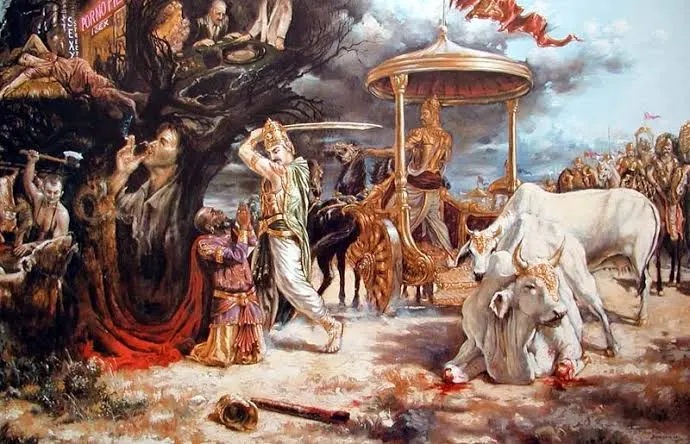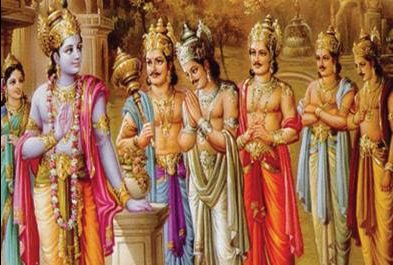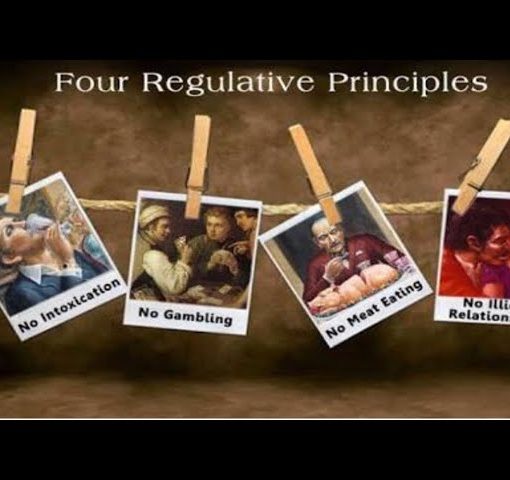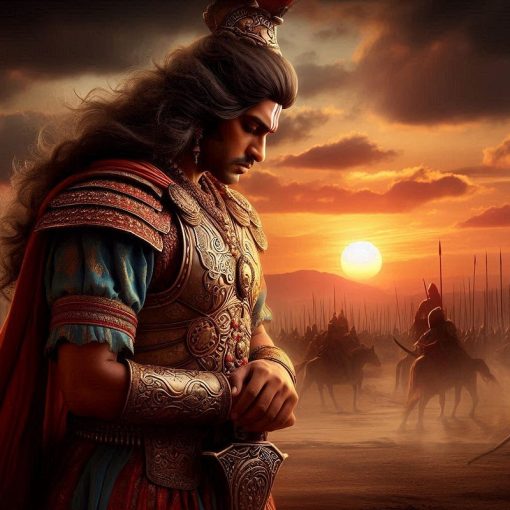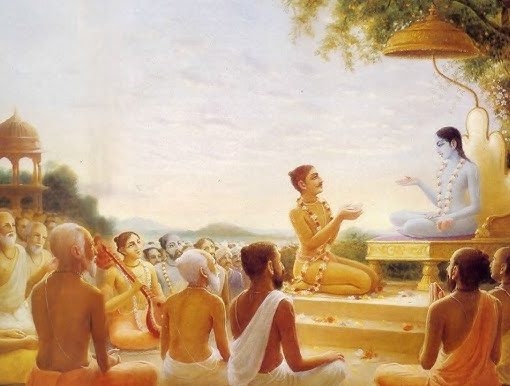In Chapter 16 of the Śrīmad-Bhāgavatam, titled “How Parīkṣit Received the Age of Kali,” we witness an important phase in history as Mahārāja Parīkṣit, the grandson of Arjuna, comes face-to-face with the beginning of the Kali-yuga. This chapter reveals the early manifestations of Kali-yuga, the Age of Quarrel and Hypocrisy, and highlights Parīkṣit’s courageous and dharmic response to protect his kingdom and subjects from its corrupting influences.
The Transition to Kali-yuga: A New Era Unfolds
The chapter begins by acknowledging the inevitable passage of time, as Kali-yuga slowly starts to make its presence felt after the departure of Lord Krishna. The influence of this age is characterized by increasing selfishness, dishonesty, and moral degradation. As the era of Dvāpara-yuga concludes, Kali-yuga gradually begins to seep into society, bringing with it adverse qualities that are alien to the principles of dharma.
The narrative introduces us to Mahārāja Parīkṣit, a righteous king who was destined to rule at this critical juncture. As a monarch in the line of the Pāṇḍavas, he is deeply committed to upholding dharma. Parīkṣit is not only an able ruler but also a devotee of Lord Krishna. Despite the foreboding signs of Kali-yuga, Parīkṣit maintains an optimistic spirit, understanding that the power of bhakti (devotion) can overcome even the darkest influences.
Lesson:
The advent of Kali-yuga teaches us that change is an inevitable part of life. As spiritual seekers, we should be prepared to face challenges that arise due to changing circumstances, both internally and externally. Just as Parīkṣit resolved to face the age of Kali with determination, we too must be resilient and unwavering in our commitment to spiritual values.
The Emergence of Adharma: The Bull and the Cow
During his tour of the kingdom, Parīkṣit comes across a shocking scene—a cow and a bull being mercilessly beaten by a low-class man dressed as a king. The cow, representing Mother Earth (Bhūmi), symbolizes the source of nourishment and is the mother of all living entities. The bull represents dharma (righteousness), standing on just one leg at this point, symbolizing the decline of virtue in the age of Kali.
The bull of dharma questions the cow about her suffering, asking if it is caused by the loss of her calves, famine, disease, or the absence of Krishna. The bull’s questions are a symbolic representation of the pain felt in Kali-yuga—dharma is under attack, and Mother Earth is burdened by sinful activities. The sight of this cruelty infuriates Parīkṣit, who immediately draws his sword to protect the bull and cow from harm.
Lesson:
The bull and the cow represent the foundational pillars of a peaceful society—righteousness and compassion. Their protection is synonymous with maintaining moral integrity and ethical values. In our lives, we should stand up against injustices and take action to protect those who are weak, vulnerable, or oppressed. Parīkṣit’s response inspires us to be courageous defenders of dharma, even in the face of adversity.
Kali’s Deception: The False King
The cruel man beating the cow and bull is identified as none other than Kali himself, who has taken the form of a king to deceive the people. Parīkṣit, realizing Kali’s identity, is filled with righteous anger. He understands that Kali’s intention is to weaken dharma by spreading confusion and hypocrisy among the people.
However, Kali, seeing Parīkṣit’s valor and power, becomes fearful and immediately surrenders to the king, seeking his mercy. Parīkṣit is a warrior by nature, but he is also compassionate. While he knows that Kali must be punished, he also recognizes that the age of Kali is ordained by divine arrangement and cannot be entirely eliminated.
In a strategic and dharmic move, Parīkṣit gives Kali certain places to reside: where there is gambling, intoxication, prostitution, animal slaughter, and gold hoarding. These five places represent the primary vices that dominate Kali-yuga. By limiting Kali to these areas, Parīkṣit demonstrates his wisdom in containing the influence of adharma while allowing space for free will to operate in this material world.
Lesson:
Kali’s surrender to Parīkṣit and the king’s decision to confine Kali to specific vices teach us the importance of discrimination and vigilance in our spiritual journey. While we may not be able to eliminate the negative influences of the world, we can certainly minimize their impact by consciously avoiding activities that lead to spiritual degradation. It is crucial to identify our vulnerabilities and take proactive measures to protect ourselves from maya’s allure.
Parīkṣit’s Dilemma: Balancing Duty and Compassion
While Parīkṣit’s immediate instinct was to kill Kali, he also recognized that even the age of Kali has a purpose in the grand scheme of creation. Kali-yuga is marked by challenges, but it also offers a unique advantage: the simple process of bhakti-yoga can lead to rapid spiritual advancement. The holy name of Krishna, when chanted sincerely, has the power to purify even the most degraded consciousness.
This insight prompts Parīkṣit to show mercy to Kali, but only under the condition that Kali will not exploit the opportunities given to him. Parīkṣit thus embodies the qualities of a true leader: strength, compassion, wisdom, and the ability to make difficult decisions for the greater good.
Lesson:
Parīkṣit’s handling of Kali is a lesson in the art of balance—balancing strength with compassion, discipline with mercy, and duty with empathy. As spiritual seekers, we must cultivate these qualities to navigate the complexities of life. It is essential to remain steadfast in dharma while being aware of the limitations and potential for transformation inherent in all living beings.
The Bull of Dharma’s Four Legs: Truth, Cleanliness, Mercy, and Austerity
In the age of Satya-yuga, dharma stands firmly on four legs: truth, cleanliness, mercy, and austerity. However, as each age progresses, one leg of dharma is gradually lost until, in Kali-yuga, only the leg of truth remains. The bull of dharma, now standing on one leg, reflects the critical state of righteousness in Kali-yuga.
Truthfulness is the foundation of spiritual progress, and it is the only leg that survives in Kali-yuga. However, even this leg is threatened as the age of quarrel advances, making it imperative for spiritual practitioners to prioritize honesty, integrity, and authenticity in their lives. By adhering to truthfulness, one can resist the corrupting influence of Kali and maintain spiritual strength.
Lesson:
The bull’s plight reminds us that truthfulness is not only a virtue but also a necessity for spiritual growth. As seekers, we must cultivate truth in our thoughts, words, and actions. By embracing truth, we become beacons of spiritual integrity and set a positive example for others to follow.
Mother Earth’s Lament: The Loss of Krishna’s Presence
Mother Earth, represented by the cow, laments the loss of Lord Krishna’s presence, which was a source of nourishment, protection, and bliss. With Krishna’s departure, she feels exposed to the rampant greed, violence, and exploitation that characterize Kali-yuga. Her suffering symbolizes the plight of the earth in an age dominated by materialism and neglect of spiritual values.
The compassionate nature of Parīkṣit is evident in his interaction with the cow. He consoles her and assures her that as long as he rules the kingdom, he will uphold Krishna’s teachings and protect her from further harm. His promise is not just a vow to protect Mother Earth but also a commitment to spiritual principles in governance.
Lesson:
Mother Earth’s lament is a wake-up call for humanity to reconnect with nature and spiritual values. It emphasizes the need for compassion towards the environment and a sense of responsibility towards maintaining harmony in creation. As spiritual practitioners, we should strive to live in a way that honors and protects the earth, recognizing it as a manifestation of Krishna’s energy.
Kali’s Impact and the Importance of Bhakti-yoga
While Kali-yuga brings with it many challenges, it also offers a great blessing: the practice of bhakti-yoga is both the easiest and most effective way to achieve spiritual realization. In this age, the chanting of the holy names of Krishna is the recommended process for liberation. By sincerely chanting and engaging in devotional service, even a fallen soul can attain Krishna’s mercy and transcend the effects of Kali.
Parīkṣit’s encounter with Kali reminds us that bhakti is a lifeline in Kali-yuga. Despite the age’s inherent difficulties, the path of devotion offers a powerful antidote to the contamination of the heart. Through association with devotees, regular study of the Bhāgavatam, and dedicated chanting, one can rise above the influence of Kali and experience spiritual bliss.
Lesson:
Kali’s impact serves as a reminder that spiritual discipline is vital, especially in challenging times. We should prioritize bhakti-yoga as the central focus of our lives, understanding that it is the most effective means to combat the negative influences of the age. By cultivating sincerity, humility, and gratitude, we can awaken our love for Krishna and inspire others to do the same.
Conclusion: Embracing the Challenges of Kali-yuga with Faith
The Sixteenth Chapter of the Śrīmad-Bhāgavatam serves as a guide for navigating the complexities of Kali-yuga. It teaches us that while the age of quarrel presents many obstacles, it also offers unique opportunities for spiritual advancement. Through the example of Mahārāja Parīkṣit, we learn the importance of righteous leadership, compassionate protection, and strategic thinking in preserving dharma.
As we journey through Kali-yuga, let us draw inspiration from Parīkṣit’s determination, the cow’s resilience, and the bull’s steadfastness. By embracing bhakti-yoga and aligning ourselves with the eternal truths of the Bhāgavatam, we can rise above the challenges of this age and contribute to a more spiritually conscious world.

